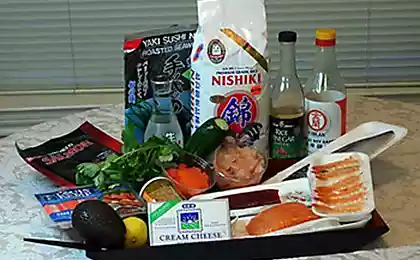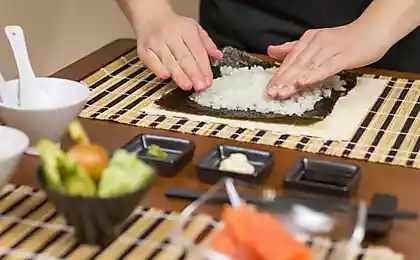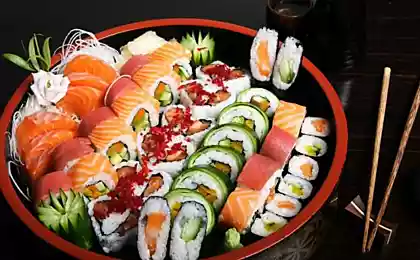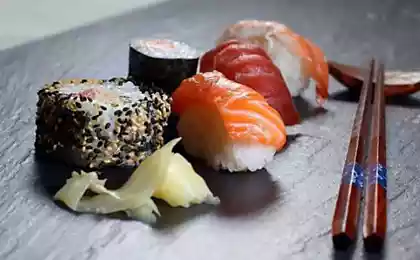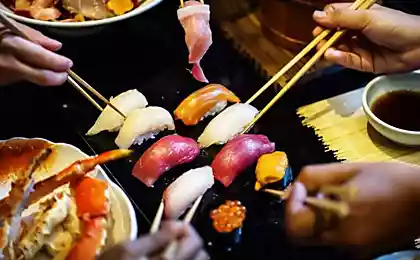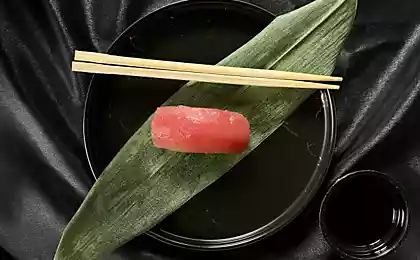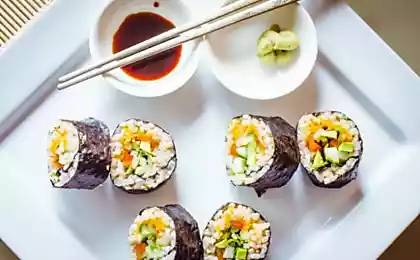232
What you need to know about sushi and rolls of the modern hostess
Someone loves sushi, and someone is just going to try this dish, proudly called the hallmark of Japanese cuisine. But there are so many varieties of sushi that you simply do not understand what gastronomic delight is better to get acquainted with in the first place.
So today's editorial office. "Site" It will help to understand how sushi differs from rolls, and which varieties are most popular. We'll also tell you. How to properly prepare rolls at homeSo you can cement the theory with a delicious lunch.

First of all, we note that both sushi and rolls are prepared from seafood and rice. Sushi is the common name for such dishes, and so are often called lumps of rice covered with fish or seafood and rewound with algae.
As for rolls, this is a kind of sushi, which is characterized by a rounded shape (due to twisting), special fillings, spices and a variety of their combination. Due to the interesting shape, it is the rolls that are very popular.

In Japanese cuisine, rolls are called norimaki, maki or makizushi (which translates as “rolled sushi”). Traditionally, each serving consists of 6, 8 or 12 pieces.
One of the most common in Japan can be safely called hosomaki. They're thin monorolls. Hosomaki filling consists of one type of fish or one type of seafood. Most often they are cooked with salmon, eel or tuna. Rice and other fillings are wrapped in red algae, which the Japanese call “nori”.

Futomaki are also popular, which are also called “big rolls”. In this dish, the filling consists of several types of fish or seafood, and turns all thick algae.
Uramaks are different in that they seem to be turned inside out. Algae (nori) are inside, and a variety of filling is kept outside. In many ways, such roles are popular due to the spectacular appearance and rich taste.

Gunkan-maki are also in demand, which have the form of ships (sometimes called so). They are characterized by an oval shape and a filling located on top. Most often cooked with rice and caviar.
Note also oshizushi - pressed sushi, having the form of beautiful bars. When cooking here, filling and rice are laid out in layers, then everything is compressed with special wooden devices (oshibako) and cut into pieces.
When the world began to get acquainted with Japanese cuisine, sushi in different countries began to cook in their own way. So, in the United States, the rolls “California” and “Philadelphia” became popular. And today we offer Prepare Philadelphia Rolls at HomeI wanted to know why Americans liked this dish.

The ingredients
Preparation
Home cooked rolls will be as tasty as in a good establishment. And it will turn out to be several times cheaper, which means that for the same money you can not only yourself. tasteBut also feed the whole family a delicious meal.
So today's editorial office. "Site" It will help to understand how sushi differs from rolls, and which varieties are most popular. We'll also tell you. How to properly prepare rolls at homeSo you can cement the theory with a delicious lunch.

First of all, we note that both sushi and rolls are prepared from seafood and rice. Sushi is the common name for such dishes, and so are often called lumps of rice covered with fish or seafood and rewound with algae.
As for rolls, this is a kind of sushi, which is characterized by a rounded shape (due to twisting), special fillings, spices and a variety of their combination. Due to the interesting shape, it is the rolls that are very popular.

In Japanese cuisine, rolls are called norimaki, maki or makizushi (which translates as “rolled sushi”). Traditionally, each serving consists of 6, 8 or 12 pieces.
One of the most common in Japan can be safely called hosomaki. They're thin monorolls. Hosomaki filling consists of one type of fish or one type of seafood. Most often they are cooked with salmon, eel or tuna. Rice and other fillings are wrapped in red algae, which the Japanese call “nori”.

Futomaki are also popular, which are also called “big rolls”. In this dish, the filling consists of several types of fish or seafood, and turns all thick algae.
Uramaks are different in that they seem to be turned inside out. Algae (nori) are inside, and a variety of filling is kept outside. In many ways, such roles are popular due to the spectacular appearance and rich taste.

Gunkan-maki are also in demand, which have the form of ships (sometimes called so). They are characterized by an oval shape and a filling located on top. Most often cooked with rice and caviar.
Note also oshizushi - pressed sushi, having the form of beautiful bars. When cooking here, filling and rice are laid out in layers, then everything is compressed with special wooden devices (oshibako) and cut into pieces.
When the world began to get acquainted with Japanese cuisine, sushi in different countries began to cook in their own way. So, in the United States, the rolls “California” and “Philadelphia” became popular. And today we offer Prepare Philadelphia Rolls at HomeI wanted to know why Americans liked this dish.

The ingredients
- 100-120g roundgrain rice
- 50g soft cheese (Philadelphia cheese or analogues)
- 70-100g salmon
- 1 cucumber
- 1 avocado
- 0.5 nori sheets
- 10ml rice vinegar
- salt, sugar to taste
Preparation
- Wash the rice under running water. Put it in a pot, fill it with water and put it on a big fire. When the water boils, reduce the fire to a minimum, cover the lid and boil until ready.
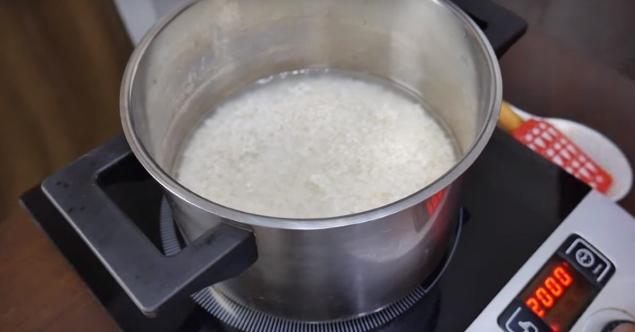
- While rice is being prepared, fish should be taken care of. Separate the scales so that the fillet looks perfectly clean. Better to work with a very sharp knife. And to remove all the excess and cut the fish into roll plates was easier, it is better to keep it in the freezer for half an hour.

- Put the finished rice in a separate container. Sugar and salt dissolve in rice vinegar and add to rice. Careful, but mix thoroughly. Cover with a clean towel and let it cool.
- Slice the cucumber with a thin straw (without seeds). Peel the avocado, remove the bone and skin, cut the straw too.
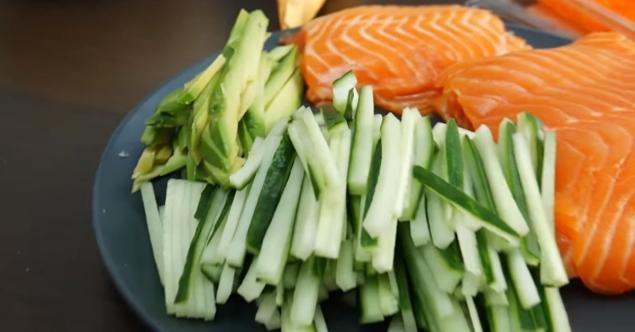
- Mat for sushi can be pre-wrapped with food film for comfortable work. You can lubricate the top with a drop of vegetable oil so that the rice does not stick.
- Put half the nori sheet on the mat. Place the rice on top so that it protrudes 1 cm from one edge of the sheet and 1 cm does not reach the end of the other edge. So that rice does not stick to your hands, soak them with water.
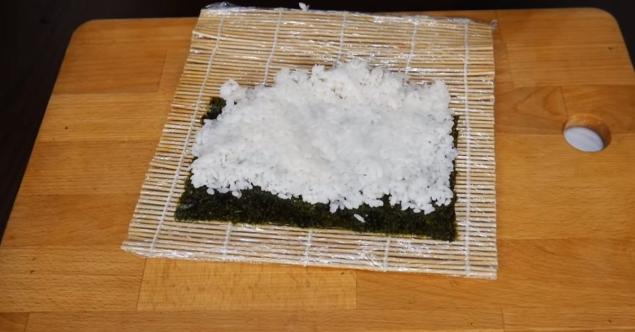
- With a mat, press the rice against a nori leaf and turn it over. Apply soft cheese on the back.
- Stack the cucumber and the avocado. If desired, you can add caviar or other ingredients, but this is already to your taste.

- Squeeze the stuffing and twist the roll.
- Evenly apply strips of salmon and press again with a mat so that the filling holds well and looks appetizing. It remains only to cut the dish into even pieces and try. Bon appetit!
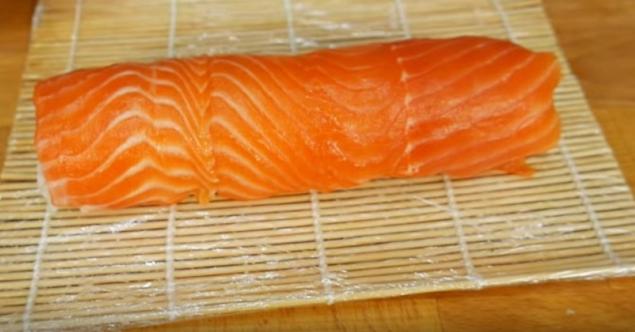
Home cooked rolls will be as tasty as in a good establishment. And it will turn out to be several times cheaper, which means that for the same money you can not only yourself. tasteBut also feed the whole family a delicious meal.






